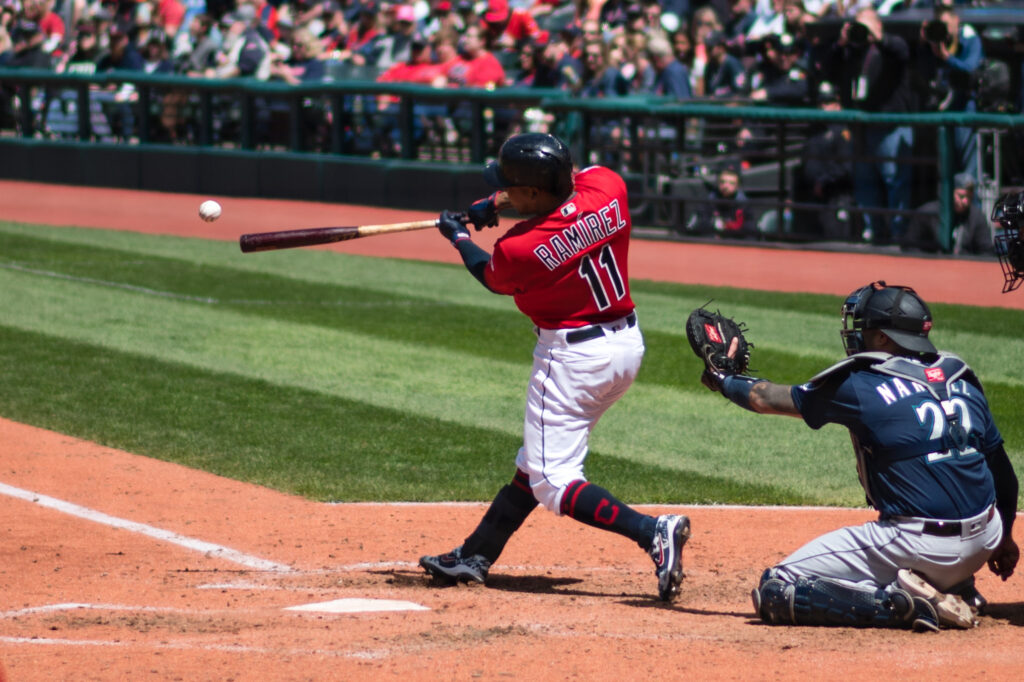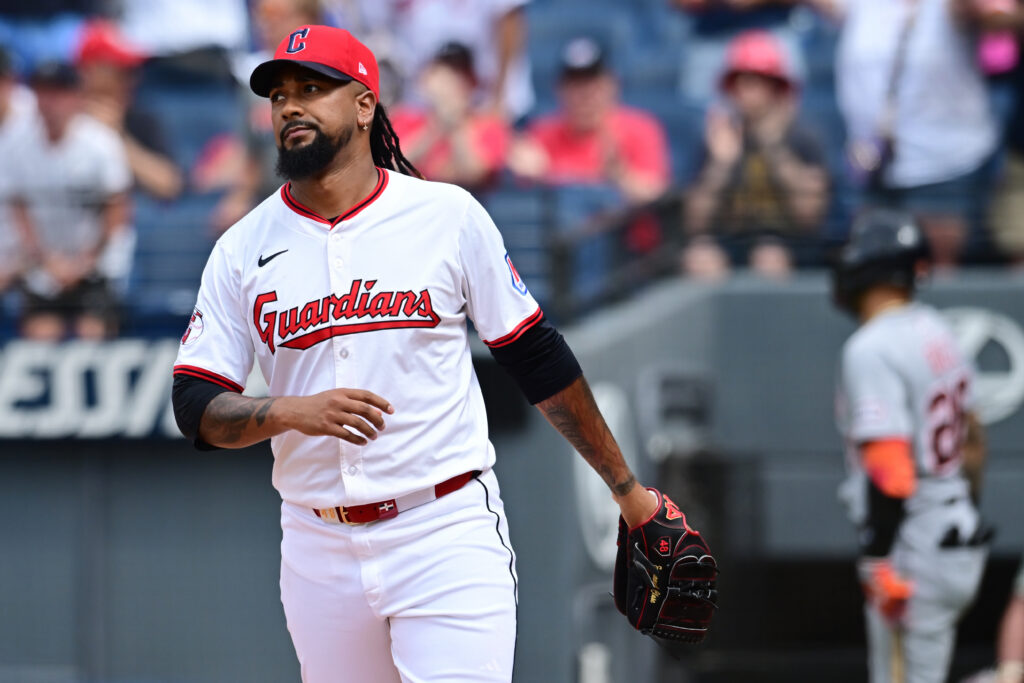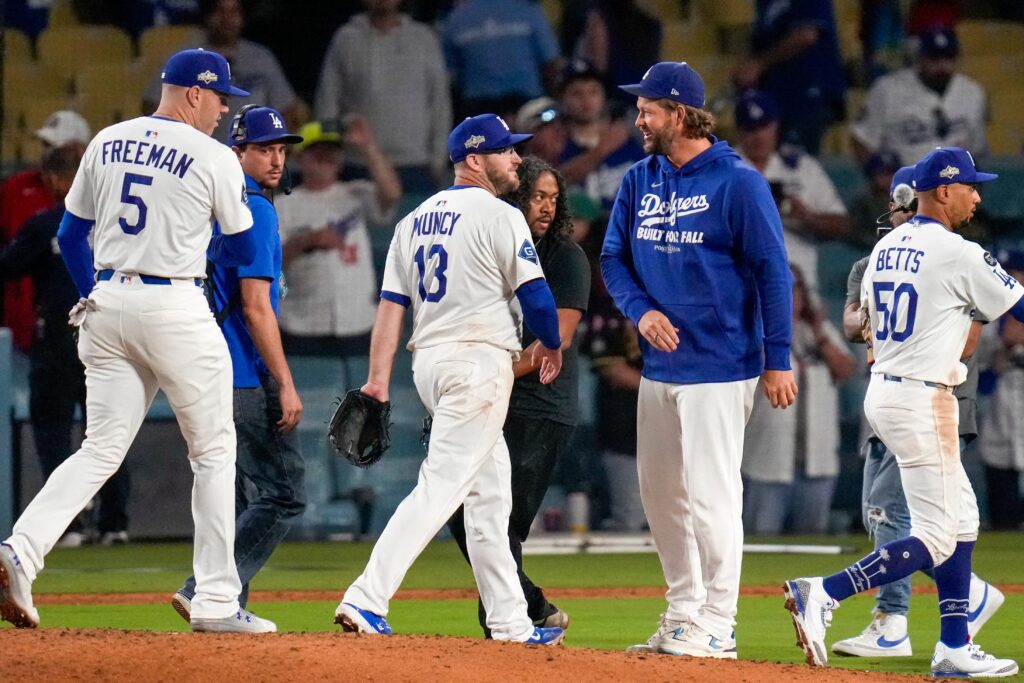This is the second article in a series that looks at the five best players at each position for the Cleveland Indians/Guardians franchise. In this installment are first and third basemen, as well as designated hitters.
The list of best Cleveland Indians/Guardians corner infielders and designated hitters features two top-tier first basemen, two third basemen who were stars on the World Series teams in 1948 and ’54, and another who currently patrols the “hot corner” at Progressive Field.
The Best First and Third Basemen and Designated Hitters in Cleveland Guardians History
First Basemen
Honorable Mentions – George Stovall was a starter in the early years of the franchise, playing eight seasons with the Naps from 1904-11. He batted .266 with 955 hits, 376 runs batted in and 110 stolen bases in 379 games, and he won fielding titles in each of his final four years in Cleveland.
Wheeler “Doc” Johnston played 12 seasons with Cleveland in two stints (1912-14 and 18-21). His best season was 1920, when he hit .292 and set career highs with 156 hits and 71 runs batted in. Overall, Johnston batted .273 with 673 hits and 248 RBIs in 721 games. He went 3-for-11 in Cleveland’s victory over Brooklyn in the 1920 World Series.
Ed Morgan spent six seasons with the Indians (1928-33), and he is tied for sixth in team history with a .323 career average. In 1930, he batted .349 and set career highs with 122 runs, 204 hits, 47 doubles, 26 home runs and 136 runs batted in.
Paul Sorrento was a solid producer during his four seasons in Cleveland (1995). In his final season with the club, he had 25 home runs and 79 RBIs, and he totaled seven hits, four runs and an RBI in 13 playoff games, helping the Indians reach the World Series. Sorrento batted .261 with 408 hits, 75 homers and 266 RBIs in 487 games.
5. Mike Hargrove – One of the team’s most successful managers spent seven seasons playing for the Indians (1975-87). Known for his rituals before and during at-bats, the “Human Rain Delay” set career highs with 179 hits and 85 RBIs in 1980 and led the American League with a .424 on-base percentage the following year. Hargrove batted .292 and totaled 860 hits and 383 RBIs in 888 games with Cleveland.
4. George Burns – He played in the World Series in his first year with the club and spent seven seasons in Cleveland (1920-21 and 24-28). Burns won the American League MVP Award in 1926, hitting .358 with 97 runs scored, 115 runs batted in and a league-leading 216 hits. He also topped the circuit with 64 doubles, a mark that is tied for the second-best single season total in Major League history (Earl Webb had 67 for the Red Sox in 1931).
Overall, Burns ranks fifth in franchise history with a .327 average, and he also had 402 runs, 853 hits, 230 doubles and 432 RBIs in 757 games. He went 3-for-10 with a run scored and three RBIs in the World Series win over the Brooklyn Robins (later known as the Dodgers) in 1920.
3. Carlos Santana – “Slamtana” spent 10 seasons with Cleveland in two stints (10-17 and 19-20), with five at first base, four at catcher and one at designated hitter. He won a fielding title in 2015, won the Wilson Defensive Player of the Year Award in 2017 and led the league in walks twice. He earned his only All-Star selection in 2019 after setting or tying career highs with a .281 average, 110 runs, 161 hits, 34 home runs and 93 runs batted in. Santana is tied for fifth in franchise history with 216 homers, and he also amassed 717 runs, 1,197 hits and 710 RBIs in 1,334 games.
2. Hal Trosky – Despite never being named an All-Star, he was a steady run producer during his nine-year run with the Indians (1933-41). Trosky had at least 150 hits seven times, drove in 100 or more runs in six straight seasons, blasted at least 25 home runs six times and finished second in fielding percentage four times. If the Rookie of the Year Award had been around in 1934, he would have won it after hitting .330 with 35 homers and 142 RBIs.
Trosky’s best seasons was 1936, when he set career highs in every major offensive category, including a .343 average, 124 runs, 216 hits, 45 doubles and 42 home runs. He led the league with 162 runs batted in (which is also the second-highest total in team history), and he also set the franchise record with 408 total bases. Trosky ranks fourth in franchise history in RBIs (911), tied for fifth in home runs (216), sixth in total bases (2,406) and tenth in doubles (287) to go with a .313 average and 757 runs and 1,365 hits in 1,124 games.
He was part of a group of players who got so sick of manager Ossie Vitt that they arranged to meet with Alva Bradley during the 1940 season. The owner sided with Vitt and when the press found out about the meeting, the players were labeled the “Cleveland Crybabys” and faced flying baby bottles thrown by opposing fans (Vitt was eventually fired after the season). Trosky retired in 1941 after suffering from severe migraines and had two separate comeback attempts in 1944 and ’46 before ending his playing career for good.
1. Jim Thome – He played the majority of his time at first base, but he also appeared as a designated hitter and even spent three seasons at third base during his 13-year run in Cleveland (1991-2002 and 2011). Thome was a three-time All-Star selection, was named a silver slugger in 1996, led the league in walks three times and strikeouts twice, and he had six seasons in which he had at least 30 home runs and 100 runs batted in.
His best season was 2002, when he hit .304 with 118 RBIs and a franchise-record 52 homers. Thome is the all-time franchise leader with 337 home runs, walks (1,008) and strikeouts (1,400), and he also ranks second in RBIs (937), fourth in total bases (2,667) and fifth in runs (928). He also batted .287 with 1,353 hits and 263 doubles in 1,399 games. In the playoffs, Thome had 43 hits, 32 runs, 17 home runs and 36 RBIs in 55 games with the Indians, and he appeared in both World Series runs in the late 1990s. Thome ranks eight in Major League history with 612 home runs, and he was inducted into the Baseball Hall of Fame in 2018.
Third Basemen
Honorable Mentions – Larry Gardner spent six years in Cleveland (1919-24), hitting .301 with 693 hits and 401 RBIs in 673 games. He had 100 or more RBIs in consecutive seasons, and he set career highs with a .319 average, 101 runs, 187 hits, 32 doubles and 120 runs batted in. Gardner had five hits and two RBIs in the 1920 World Series.
Max Alvis was a two-time All-Star during his eight-year stint with the Indians (1962-69). His best season was 1967, went he hit 21 home runs and set career highs with 163 hits and 70 RBIs. Overall, he had 874 hits, 108 homers and 361 RBIs in 951 games.
Colbert “Toby” Harrah spent five seasons with Cleveland (1979-83) and was an All-Star in 1982, when he hit 25 home runs, drove in 78 runs and set career highs with a .304 average, 100 runs and 183 hits. The 1983 fielding champion batted .281 with 444 runs, 725 hits, 70 homers and 324 RBIs in 712 games.
Travis Fryman came to Cleveland after eight seasons with Detroit. He won the fielding title and earned an All-Star selection in 2000, when he hit 22 home runs and posted career highs with a .321 average, 184 hits, 38 doubles and 106 runs batted in. Fryman batted .274 with 600 hits, 74 homers and 343 RBIs in 602 games. He added 13 hits, nine runs, one home run and six RBIs in 20 playoff games with the Indians.
5. Brook Jacoby – He was a two-time All-Star who played nine seasons with the Indians (1984-91 and 92) and posted a .300-32-69 stat line in 1987. Jacoby batted .273 with 521 runs, 1,787 hits, 120 home runs and 524 RBIs in 1,240 games.
4. Bill Bradley – He was the starter for the franchise’s first ten seasons (1901-10) and won four fielding titles in that span. In 1902, Bradley set career highs with a .340 average, 104 runs, 187 hits, 39 doubles, 22 triples, 11 home runs and 77 runs batted in. Bradley ranks tenth in team history with 157 stolen bases and is tied for tenth with 74 triples. He also batted .272 with 649 runs, 1,265 hits and 473 RBIs in 1,331 games.
3. Al Rosen – The four-time All-Star called Cleveland home for ten seasons (1947-56), which included two World Series appearances. He was known for his toughness, which came from facing antisemitism throughout his career. Rosen was named American League MVP in 1953 when he led the league in 115 runs, 43 home runs and 145 runs batted in, and he also set career highs with a .336 average and 201 hits. He also led the league with 37 homers in 1950 and 105 RBIs in 1952.
“Flip” had five straight seasons with at least 20 home runs and 100 RBIs. He batted .285 and totaled 603 runs, 1,063 hits, 192 home runs and 717 RBIs in 1,044 games. Rosen had one at-bat in the 1948 World Series victory and went 3-for-12 in the loss to the Giants in 1954.
2. Jose Ramirez – He has been a five-time All-Star and a four-time silver slugger (so far) during his 11 seasons in Cleveland. Ramirez has been in the top six in the MVP voting five times and was a runner-up in the COVID-shortened 2020 season after hitting .292 with 17 home runs, 46 RBIs and a league-high 45 runs in 58 games. He has led the American League in doubles twice, including 2017 when he had 56, which is the third-highest single-season total in team history. In 2022, Ramirez had his best season, posting a .280-29-136 stat line with the RBI total being a career high.
“Enriquito” ranks sixth in team history in doubles (320), seventh in stolen bases (174) and ninth in both home runs (213) and total bases 92,324). He also has batted .279 with 772 runs, 1,291 hits and 737 RBIs in 1,262 games. Ramirez has been stellar in the playoffs, totaling 30 hits, 11 runs, seven doubles, two homers and 12 RBIs in 32 games. He had nine hits and hit a home run during the Indians loss to the Cubs in the 2016 World Series.
1. Ken Keltner – He spent 12 of his 13 seasons in Cleveland (1937-49, missing 1945 due to military service) and was a seven-time All-Star. Keltner’s best season was 1948, when he hit .297 and posted career highs with 91 runs, 31 home runs and 119 runs batted in. He hit a three-run home run in the one-game playoff against the Red Sox to send the Indians to the World Series that year. Against the other Boston squad, the Braves, Keltner went 2-for-21 with three runs scored as Cleveland won its first title since 1921.
Keltner ranks fifth in franchise history in total bases (2,494), tied for sixth in games (1,513), seventh in doubles (306) and RBIs (850) and eighth in hits (1,561). He also hit .276 with 735 runs, 69 triples and 163 home runs in his Indians career. Despite all his offensive accolades, the three-time fielding champion was best-known for one particular game. On July 17, 1941, Yankees star Joe DiMaggio was looking to continue his hitting streak. Keltner made two spectacular backhanded plays to rob “Joltin’ Joe” of hits, as his record 56-game streak came to an end.
Designated Hitters
5. Rico Carty – An All-Star and batting champion with the Braves in 1970, he came to the Indians later in the decade. Carty spent four seasons with Cleveland (1974-77), hitting .303 with 451 hits, 47 home runs and 243 RBIs in 430 games.
4. Franmil Reyes – His best season came in 2021 when he smacked 30 home runs and drove in a career-best 85 runs. In four seasons with Cleveland (2019-22), “The Franimal” had 261 hits, 58 homers and 182 RBIs in 295 games. The current Royals reserve scored two runs in the 2020 Wild Card round.
3. Ellis Burks – The two-time All-Star came to the Indians near the end of an 18-year career. He hit .301 with 92 runs, 156 hits, 32 home runs and 91 RBIs in 2002 and won the Edgar Martinez Award for best designated hitter. Burks batted .287 with 331 hits, 66 homers and 193 RBIs in 317 games. He had six hits, four runs scored and a home run in the five-game loss to the Mariners in the 2001 Division Series.
2. Travis Hafner – He played 10 seasons with the Indians (2003-12), posting at least 20 home runs and 100 RBIs in four of them. When Jim Thome signed with the Phillies as a free agent, the Indians traded for Hafner to replace him. His best season with 2006, when he hit .308 with 100 runs, 140 hits, 42 homers and 117 RBIs while leading the league with a .659 slugging percentage.
“Pronk” (a combination of his two other nicknames, “Donkey” and “The Project”) ranks tenth in franchise history with 200 home runs and he also batted .278 with 582 runs, 1,039 hits, 238 doubles and 688 RBIs in 1,078 games. Hafner totaled eight hits, six runs, two homers and 4 RBIs in 11 games during the 2007 playoffs, which ended with a seven-game loss to the Red Sox in the ALCS.
1. Andre Thornton – He was a two-time All-Star who played 10 seasons with Cleveland in two stints (1977-79 and 81-87). Thornton’s best season was 1982, when he hit .273 with 90 runs and 32 home runs and set career highs with 161 hits and 116 runs batted in. He also won the Roberto Clemente Award in 1979, won the Hutch Award in 1982 and earned a silver slugger in 1984.
“Thunder” ranks eighth in team history with 214 home runs, although he was second at the time of his retirement and would have been first if he hadn’t lost the entire 1980 season and more than half of 1981 after undergoing two surgeries on his right knee. Thornton also had 650 runs, 1,095 hits and 749 RBIs in 1,225 games.
Upcoming Stories
Cleveland Guardians Catchers and Managers
Cleveland Guardians Second Basemen and Shortstops – coming soon
Cleveland Guardians Outfielders – coming soon
Cleveland Guardians Pitchers – coming soon
Previous Series
A look back at the Cincinnati Reds
Cincinnati Reds Catchers and Managers
Cincinnati Reds First and Third Basemen
Cincinnati Reds Second Basemen and Shortstops
Cincinnati Reds Outfielders
Cincinnati Reds Pitchers
A look back at the Chicago White Sox
Chicago White Sox Catchers and Managers
Chicago White Sox First and Third Basemen and Designated Hitters
Chicago White Sox Second Basemen and Shortstops
Chicago White Sox Outfielders
Chicago White Sox Pitchers
A look back at the Chicago Cubs
Chicago Cubs Catchers and Managers
Chicago Cubs First and Third Basemen
Chicago Cubs Second Basemen and Shortstops
Chicago Cubs Outfielders
Chicago Cubs Pitchers
A look back at the Boston Red Sox
Boston Red Sox Catchers and Managers
Boston Red Sox First and Third Basemen
Boston Red Sox Second Basemen and Shortstops
Boston Red Sox Outfielders and Designated Hitters
Boston Red Sox Pitchers
A look back at the Baltimore Orioles
Baltimore Orioles Catchers and Managers
Baltimore Orioles First and Third Basemen
Baltimore Orioles Second Basemen and Shortstops
Baltimore Orioles Outfielders and Designated Hitters
Baltimore Orioles Pitchers
A look back at the Atlanta Braves
Catchers and Managers
First and Third Basemen
Second Basemen and Shortstops
Outfielders
Pitchers
A look back at the Arizona Diamondbacks
Catchers and Managers
First and Third Basemen
Second Basemen and Shortstops
Outfielders
Pitchers



